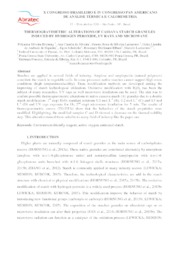Thermogravimetric alterations of cassava starch granules induced by hydrogen peroxide, UV rays and microwave.
Thermogravimetric alterations of cassava starch granules induced by hydrogen peroxide, UV rays and microwave.
Author(s): HORNUNG, P. S.; SILVEIRA, A. C. da; LAZZAROTTO, S. R. da S.; SIQUEIRA, G. L. de A. de; SCHNITZLER, E.; RIBANI, R. H.; LAZZAROTTO, M.
Summary: Starches are applied in several fields of industry. Amylose and amylopectin (natural polymers) constitute the starch in vegetable cells. In some processes native starches cannot support high stress conditions (high temperatures/acidity). Then, modification methods are developed aiming the improving of starch technological utilization. Oxidative modification with H2O2 has been the subject of many researches. UV rays as well microwave irradiation can be used. The aim was to confirm possible thermogravimetric alterations in native cassava starch (A) granules due to a double starch modification: 1st step) H2O2 standard solutions 0.1 mol L-1 (B), 0.2 mol L-1 (C) and 0.3 mol L-1 (D) and UV rays exposure for 1h; 2nd step) microwave irradiation for 5 min. The results of thermogravimetric curves (TG-DTA) show that the behaviors of the starch proprieties were modified. Highlighting, the modified samples C and D showed a decrease on the thermal stability step. This alteration turned them suitable to many field of industry like the paper one.
Publication year: 2016
Types of publication: Paper in annals and proceedings
Unit: Embrapa Forestry
Keywords: Active oxygen, Amido, Cassava, Environment-friendly reagent, Mandioca, Starch
Observation
Some of Embrapa's publications are published as ePub files. To read them, use or download one of the following free software options to your computer or mobile device. Android: Google Play Books; IOS: iBooks; Windows and Linux: Calibre.
Access other publications
Access the Agricultural Research Database (BDPA) to consult Embrapa's full library collection and records.
Visit Embrapa Bookstore to purchase books and other publications sold by Embrapa.

